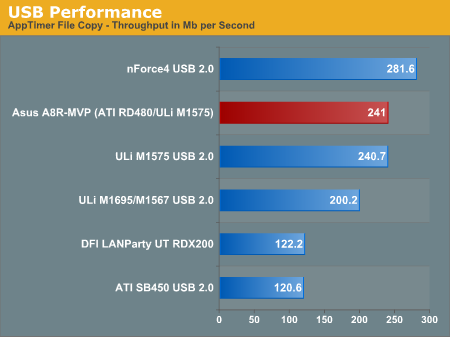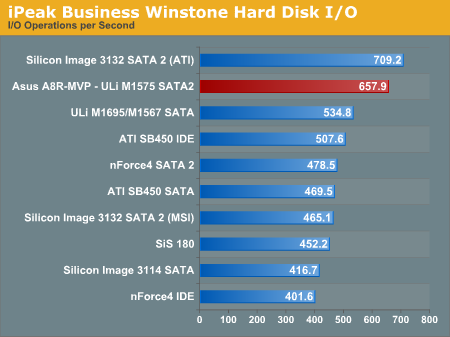Asus A8R-MVP: Mainstream Rocket
by Wesley Fink on November 23, 2005 1:15 AM EST- Posted in
- Motherboards
USB Performance
USB has been a problem area for the ATI SB450 chipset, so we were anxious to test the ULi M1575 South Bridge, which is supposed to fix USB performance issues. We ran our standard USB throughput test on the Asus A8R-MVP using an external USB hard drive.
Our test method uses a RAM disk as our “server”, since memory removes almost all overhead from the serving end. We also disable disk caching on the USB and Firewire side by setting up the drives for “quick disconnect”. Our results are then consistent over many test runs.
We use just 1GB of fast 2-2-2 system memory, set up as a 450MB RAM disk and 550MB of system memory. Our stock file is the SPECviewPerf 8.01 install file. which is 432,533,504 bytes (412.4961MB). After copying this file to our RAM disk, we measure the time for writing from the RAM disk to our external USB 2.0 or Firewire 400 or Firewire 800 drive using a Windows timing program written for AnandTech by our own Jason Clark. The copy times in seconds are then converted into Megabits per second (Mb) to provide a convenient means of comparing throughput. Higher Rates therefore mean better performance.
In addition to competitive USB performance, the M1575 also provides the SATA2 ports that are missing from the ATI SB450. The ULi SATA2 also supports RAID 0, 1, 0+1, 5, and JBOD.
Disk Controller Performance
With the variety of disk drive benchmarks available, we needed a means of comparing the true performance of the wide selection of controllers. The logical choice was Anand's storage benchmark first described in “Q2 2004 Desktop Hard Drive Comparison: WD Raptor vs. the World”. To refresh your memory, the iPeak test was designed to measure "pure" hard disk performance, and in this case, we kept the hard drive as consistent as possible while varying the hard drive controller. The idea is to measure the performance of a hard drive controller with a consistent hard drive.
We played back Anand's raw files that recorded I/O operations when running a real world benchmark - the entire Winstone 2004 suite. Intel's iPEAK utility was then used to play back the trace file of all IO operations that took place during a single run of Business Winstone 2004 and MCC Winstone 2004. The drive was formatted before each test run and a composite average of 5 tests on each controller interface was tabulated in order to ensure consistency in the benchmark.
iPeak gives a mean service time in milliseconds; in other words, the average time that each drive took to fulfill each IO operation. In order to make the data more understandable, we report the scores as an average number of IO operations per second so that higher scores translate into better performance. This number is meaningless as far as hard disk performance is concerned as it is just the number of IO operations completed in a second. However, the scores are useful for comparing "pure" performance of the storage controllers in this case.
USB has been a problem area for the ATI SB450 chipset, so we were anxious to test the ULi M1575 South Bridge, which is supposed to fix USB performance issues. We ran our standard USB throughput test on the Asus A8R-MVP using an external USB hard drive.
Our test method uses a RAM disk as our “server”, since memory removes almost all overhead from the serving end. We also disable disk caching on the USB and Firewire side by setting up the drives for “quick disconnect”. Our results are then consistent over many test runs.
We use just 1GB of fast 2-2-2 system memory, set up as a 450MB RAM disk and 550MB of system memory. Our stock file is the SPECviewPerf 8.01 install file. which is 432,533,504 bytes (412.4961MB). After copying this file to our RAM disk, we measure the time for writing from the RAM disk to our external USB 2.0 or Firewire 400 or Firewire 800 drive using a Windows timing program written for AnandTech by our own Jason Clark. The copy times in seconds are then converted into Megabits per second (Mb) to provide a convenient means of comparing throughput. Higher Rates therefore mean better performance.

In addition to competitive USB performance, the M1575 also provides the SATA2 ports that are missing from the ATI SB450. The ULi SATA2 also supports RAID 0, 1, 0+1, 5, and JBOD.
Disk Controller Performance
With the variety of disk drive benchmarks available, we needed a means of comparing the true performance of the wide selection of controllers. The logical choice was Anand's storage benchmark first described in “Q2 2004 Desktop Hard Drive Comparison: WD Raptor vs. the World”. To refresh your memory, the iPeak test was designed to measure "pure" hard disk performance, and in this case, we kept the hard drive as consistent as possible while varying the hard drive controller. The idea is to measure the performance of a hard drive controller with a consistent hard drive.
We played back Anand's raw files that recorded I/O operations when running a real world benchmark - the entire Winstone 2004 suite. Intel's iPEAK utility was then used to play back the trace file of all IO operations that took place during a single run of Business Winstone 2004 and MCC Winstone 2004. The drive was formatted before each test run and a composite average of 5 tests on each controller interface was tabulated in order to ensure consistency in the benchmark.
iPeak gives a mean service time in milliseconds; in other words, the average time that each drive took to fulfill each IO operation. In order to make the data more understandable, we report the scores as an average number of IO operations per second so that higher scores translate into better performance. This number is meaningless as far as hard disk performance is concerned as it is just the number of IO operations completed in a second. However, the scores are useful for comparing "pure" performance of the storage controllers in this case.












74 Comments
View All Comments
EnlightenedOne - Thursday, December 8, 2005 - link
Hey Wesley, Great Review!I was wondering a few things with this motherboard and the setup.
First, do you think the clawhammer 4000+ would overclock better than the Diego?
What voltage are you feeding your ram to reach such a high frequency?
Do you suggest using the 246 x 12 or the 325 x 9 set up for games?
Finally, what voltage are you feeding the PCIe slot? Also, why haven't you upped the voltage to your cpu core to maintain stability and go beyond 2 days? :)
Zebo - Thursday, November 24, 2005 - link
Great having spread out memory slots. I found many A64 boards stack the dual channel sticks so close they are actually touching between sticks fi you have heat spreaders on there and they can't cool.Price!! I sure miss top of the line boards in the $100 range (Abit NF7-S Abit IS7 etc)granted this new era has high power requirements and thus a beffier boards but no excuse for these $200+ mobos floating around for enthusiants. nV and Intel must be charging crazy high prices for thier newer chipsets.. Thanks ATI.
Legacy support - My printer won't work with full features on USB alone... needs Parallel cable for full control which my DFI does'nt have.
- overclocking potential as Mr. Fink illustrated.
- full features including Fast disk benches and great on-board audio (FWIW).
- Passive cooled mobo design - How many of you hate those whinny 40mm/60mm fans that come on mobos? When they work that is.
Asus really needs to adopt Black though for thier entire lineup unless it goes in an OEM build.. I mean that yellow traces and green board is so 1990's.:(
Live - Thursday, November 24, 2005 - link
s.I couldn’t agree more. Those small fans are highly unreliable and very noisy. And with today’s heat pipe tech there is no reason to not go passive even on the high end boards. ASUS seems to be leading the pack on this. To bad they cant/won’t go all out in their bios. DFI in particular have them beat in bios all the time.
Sxotty - Wednesday, November 23, 2005 - link
That is really not a very thoughtful way to look at it.
If ASUS was "surprised" by your results that would argue they are atypical not typical. It is not as though they never tested the motherboard to see if it worked. If you ever find an engineer surprised by your results than you should assume that they do not represent what the acerage was expected to be. Perhaps it is a wonderful overclocker, but that is evidence that it is not. Perhaps the engineer that was so "promising" really did an excellent job and the other people you spoke with just did not happen to know the test results.
Wesley Fink - Wednesday, November 23, 2005 - link
I can only report what I actually find, and we can both "suppose" all day long. Time will prove whether these overclocking results are typical or atypical.As i said in a comment above: "Asus does extensive overclocking tests on their top-line boards aimed at that market. They generally know how they will perform in overclocking. They do more modest tests on mainstream boards. It is my opinion it never occured to Asus that the A8R-MVP might be a monster overclocker until I reported my results back to them."
I have worked closely with the Asus Engineering team in Taiwan on several Enthusiast board projects, and since my initial results were shared with them after the second BIOS they have not given me any reason to expect that they are not typical for this board. As I said in the Final Words: "We would feel much more comfortable in our praise of the A8R-MVP if we had an opportunity to prove similar overclocking on another five boards pulled at random from retail shelves."
Zebo - Thursday, November 24, 2005 - link
ATI “Certified Motherboard?"?afrost - Wednesday, November 23, 2005 - link
I can't wait to get my hands on this board.....I have been waiting for a solid passively cooled board like this for a long time.The HD audio is a very nice bonus.
Wesley Fink - Wednesday, November 23, 2005 - link
We did additional tests on the Asus A8N32-SLI Deluxe Dual x16 this morning, running at our standard 1280x1024 with AA and AF turned off, with 81.87 drivers. We have added A8N32-SLI benchmarks to F.E.A.R., SC-CT, Quake 4, Doom 3, Far Cry, and Wolfenstein - Enemy Territory.The added benchmarks do not really change any of our conclusions. As you can see, the Asus A8R-MVP is very competetive with the top-line A8N32-SLI Deluxe.
nvidia4ever - Wednesday, November 23, 2005 - link
Thanks for the updates. It really does look like there is another performance choice now for AMD systems. I still would find it interesting to see how a x1800xt performs on ATIs own chipset.Duplex - Wednesday, November 23, 2005 - link
The only thing me and my friends missed is overclockingresultsfor the memory with tight timings like 1T 2-2-2-5 or 2-2-2-7.
The 1T overclocking performance for Asus and Abit has yet been very poor,
with tigh timings even worse. Abit has added higher vdimm options but it
hasn´t helped much. Has this changed with this Asus-Ati-mb or is dfi nf4
still my only option for pc-builds? 230/240/250/260 (/270) MHz???